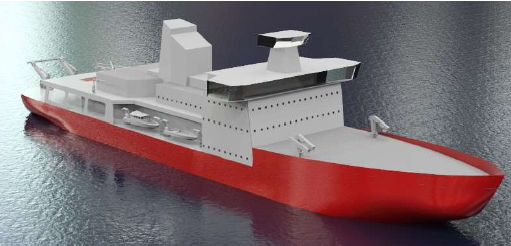Designers: Anika Breza, Rudy Caligure, Luke Kiely, and Rebecca Teitelbaum
Vessel Type: Polar Icebreaker
Vessel Mission:
The USCGC Skadi will support the U.S. Coast Guard’s missions in polar waters. It will have Search and Rescue capability, provide resupply to remote stations, and facilitate safe navigation through waterway maintenance and ship escort. It will also support law enforcement, scientific research, and environmental protection response.
Vessel Route:
This Vessel will navigate polar waters including the Chukchi and Beaufort Seas in the Arctic and McMurdo Sound in Antarctica at any time of year.
Icebreaking Requirements:
Skadi must break 2.5m of ice topped with 150mm of snow continuously at 3kts, corresponding with Polar Clas 2. She will be able to break ice ridges greater than 8m.
View Presentation
Visit our Junior Class Small Vessel Design Project page to view all of this year’s projects.
About Junior Class Small Vessel Design Project (SD1):
As a part of Professor Bradley D.M. Golden’s ’99 Ship Design 1 (SD1) class, the juniors spent the first two-and-a-half months of the spring semester preparing their first complete concept designs.
Using the knowledge they’ve gained in their nearly three years studying at Webb and the experiences from their winter work periods to date, this was the students’ first opportunity to apply the naval architecture and marine engineering principles they’ve studied including stability, ship’s structures, main machinery systems, auxiliary systems, resistance and propulsion, and electrical engineering.
Working in small groups of three and four, the students selected one of the vessel types and took their first couple of spins around the design spiral to prepare vessel concept designs. To help make the project as realistic as possible, members of industry familiar with each of the vessel types helped prepare the statements of design requirements that each of the designs had to meet. To challenge the students even further, one or two “curveballs” were thrown into each design statement to make the students think long and hard about how they would achieve their objectives.
At the end of the spring semester, the students presented their final designs to their fellow students, faculty, and members of industry who served as part of an evaluation team. After three years at Webb, the Junior class can now say with confidence that they’re familiar with the design process and are well on their way to joining the fields of naval architecture and marine engineering.

